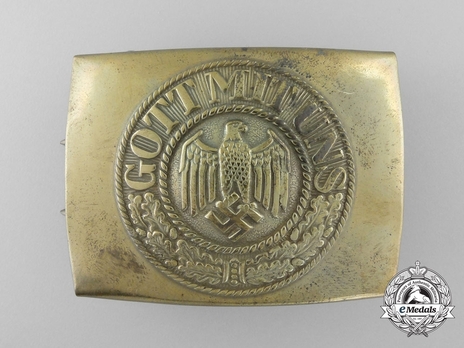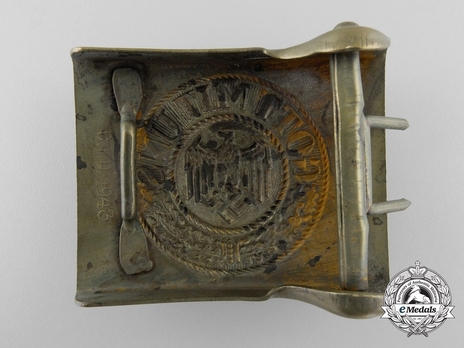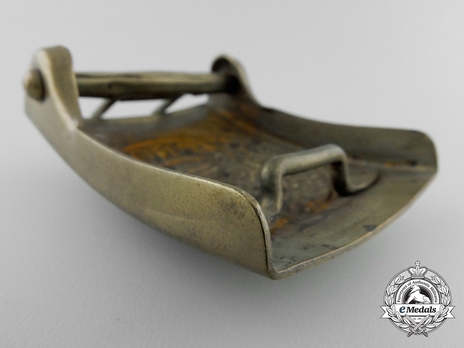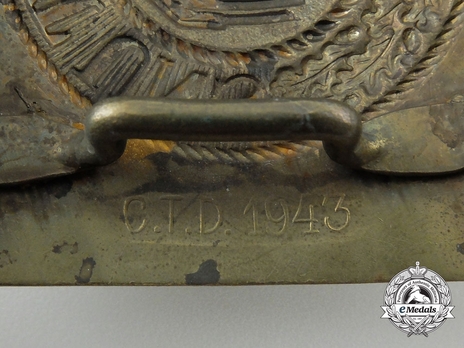Kriegsmarine NCO/EM Belt Buckle (Gilt version)
CATEGORY: Version
SKU: 21.GOR.02.02.006.000
Estimated market value:




Estimated market value:
Buckle in gilded steel (magnetic), 64.0mm x 48.5mm, marked on reverse C.T.D. 1943 (for Christian Theodore Dicke), in very fine condition.
The headgear, uniforms, and insignia worn by members of the Kriegsmarine were based upon the designs utilized by the Kaiserliche Marine (Imperial Navy) and the Reichsmarine of the Weimar Republic. The official regulations governing the uniforms of the Reichsmarine were issued on April 5, 1921, and they were embraced, with a few alterations, as the Kriegsmarine uniforms in 1935.
From 1933-1945, the uniforms worn by personnel in the German Navy were produced and disseminated by the Navy Clothing Depot and private manufacturers.
Similar to the larger uniform items, the belt straps and buckles worn by Kriegsmarine personnel were based upon those utilized during the Reichsmarine.
The NCO/EM belt strap and buckle were worn by non-commissioned and enlisted personnel, such as Non-Commissioned Officers and Privates. They wore this belt whenever ordered, as well as with the landing and guard dress, and during guard duty or infantry training.
These NCO/EM belt straps and buckles are composed of several main elements, including the leather strap, the rectangular buckle, the buckle shield, the center bar, the double buckle claws/prongs, the leather tab, the buckle catch, and the manufacturer mark.
The NCO/EM belt straps that were worn with the blue or field-grey uniforms were typically made from black leather, or more rarely from brown leather. They were also composed of olive-green webbing for wear with the tropical uniform. The strap has an approximate width of 45mm, and it features seven pairs of parallel holes for sizing.
The buckles feature several main elements, including the shield, the catch, the bar with movable roll, the leather tongue/tab, and the double claws/prongs.
The buckle is rectangular and it may be composed of brass, stamped steel, or a light metal alloy, such as aluminum. For wear with the blue uniform the buckle was generally gold-coloured, for the field-grey uniform it was painted matte-grey/blue-grey, and for the tropical uniform it tended to be painted green. In rare instances a gold-coloured buckle was worn by Senior Non-Commissioned Officers with the field-grey uniform and a matte-grey buckle was worn with the blue uniform.
The shield section may be stamped onto the buckle, or, during the Kriegsmarine, attached separately. The shield design is made up of two concentric circles. The narrow outside circle has the inscription “GOTT MIT UNS” along the top and an oak leaf wreath along the bottom, while the large interior circle features an eagle. During the Reichsmarine the eagle was the Weimar version with a right facing head, while from August 1936 onward it was a Wehrmacht eagle with a left facing head. The area inside the shield may be finely pebbled for buckles with a Wehrmacht eagle. The surface beyond the shield is generally not pebbled, it tended to be smooth in order to distinguish the Kriegsmarine belt buckles from the Heer belt buckles.
The hooked buckle catch is located along the left end of the buckle, and it was riveted to the buckle by two thin strips of metal from 1942 onward.
The bar has a movable roll, and a leather tab is wrapped around the bar and sewn shut. The bar is riveted to the buckle, and there are two claws/prongs that rest on the roll.
The marks of private manufacturers vary widely, ranging from codes to full names, and even abbreviated letters, as well as the year of manufacture. After 1942, Reich numbers (Reichsbetriebsnummer) were also used as manufacturer marks (RB-).
Known manufacturers include, but are not limited to, Christian Theodore Dicke, Josef Feix & Söhne, and Richard Sieper & Sohn.

Comments
Sign in to comment and reply.


Scroll Top